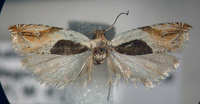Identification
Adult Markings: The following is based in part on the description by Forbes (1923). The ground color of the forewing is white and overlain with a large blackish-brown dorsal patch on the inner margin. The patch has a smooth margin and widens distally, then narrows and terminates at about the middle of the wing to produce a pearl shape when a resting individual is viewed from above. It may extend nearly two-thirds of the way out from the inner margin at its maximum width, is evenly rounded, and is cleanly delineated outwardly by a narrow band of white ground color. Beyond the white band there is an extensive zone of blackish-brown scales. These cover much of the dorsal two-thirds of the apical third of the wing, including the termen, and connect with a posteriorly oblique dark band that extends from the middle of the costa. Immediately behind the median costal band there is white ground that forms a large trapezoidal shaped patch (often with a thin dark line in the middle), and beyond this a series of short dark costal streaks that terminate at a large triangular-shaped apical spot. The fringe is dull white with brownish dusting, and the hindwing is light to medium brown with a concolorous fringe. Specimens sometimes have the narrow band of white ground color that follows the dorsal patch heavily dusted with blackish-brown.
Wingspan: 13 mm (Forbes, 1923)Forewing Length: 6.5-8.0 mm (Gilligan et al., 2008)
Adult Structural Features: Gilligan et al. (2008) have illustrations of the male and female genitalia and note that the male genitalia are very similar to members of the A. spireaeifoliana species group.
Structural photos
Adult ID Requirements: Identifiable from good quality photos of unworn specimens.
Immatures and Development: The larvae are leaf-folders that feed on Ceanothus spp. The mature larva are drab greenish yellow with an amber head capsule and greenish yellow prothoracic shield that has a black spot on each of the posterior corners. The anal plate is greenish yellow with a narrow black streak.

 »
»



 »
»

